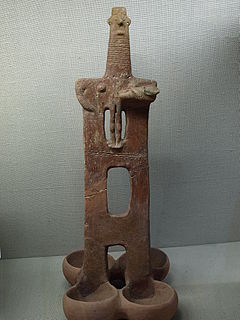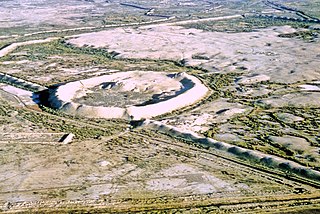
The Bronze Age is a historical period characterized by the use of bronze, and in some areas proto-writing, and other early features of urban civilization. The Bronze Age is the second principal period of the three-age Stone-Bronze-Iron system, as proposed in modern times by Christian Jürgensen Thomsen, for classifying and studying ancient societies.
The Chalcolithic, a name derived from the Greek: χαλκός khalkós, "copper" and from λίθος líthos, "stone" or Copper Age, also known as the Eneolithic or Aeneolithic is an archaeological period which researchers usually regard as part of the broader Neolithic. In the context of Eastern Europe, archaeologists often prefer the term "Eneolithic" to "Chalcolithic" or other alternatives.

Harappa is an archaeological site in Punjab, Pakistan, about 24 km (15 mi) west of Sahiwal. The site takes its name from a modern village located near the former course of the Ravi River which now runs 8 km (5.0 mi) in north. The current village of Harappa is less than 1 km (0.62 mi) from the ancient site. Although modern Harappa has a legacy railway station from the period of the British Raj, it is a small crossroads town of 15,000 people today.
The Iron Age is the final epoch of the three-age division of the prehistory and protohistory of humankind. It was preceded by the Stone Age and the Bronze Age. The concept has been mostly applied to Europe and the Ancient Near East, and, by analogy, also to other parts of the Old World.

Mehrgarh, sometimes anglicized as Mehergarh or Mehrgar, is a Neolithic site located near the Bolan Pass on the Kacchi Plain of Balochistan, Pakistan, to the west of the Indus River valley.
The Neolithic, the final division of the Stone Age, began about 12,000 years ago when the first development of farming appeared in the Epipalaeolithic Near East, and later in other parts of the world. The division lasted until the transitional period of the Chalcolithic from about 6,500 years ago, marked by the development of metallurgy, leading up to the Bronze Age and Iron Age. In Northern Europe, the Neolithic lasted until about 1700 BC, while in China it extended until 1200 BC. Other parts of the world remained broadly in the Neolithic stage of development, although this term may not be used, until European contact.

The 3rd millennium BC spanned the years 3000 through 2001 BC. This period of time corresponds to the Early to Middle Bronze Age, characterized by the early empires in the Ancient Near East. In Ancient Egypt, the Early Dynastic Period is followed by the Old Kingdom. In Mesopotamia, the Early Dynastic Period is followed by the Akkadian Empire.

The 4th millennium BC spanned the years 4000 through 3001 BC. Some of the major changes in human culture during this time included the beginning of the Bronze Age and the invention of writing, which played a major role in starting recorded history.
The 5th millennium BC spanned the years 5000 through 4001 BC. It saw the spread of agriculture from Western Asia throughout Southern and Central Europe.

A mudbrick or mud-brick is an air-dried brick, made of a mixture of loam, mud, sand and water mixed with a binding material such as rice husks or straw. Though mudbricks are known from 7000-6000 BCE, since 4000 BC, bricks have also been fired, to increase their strength and durability.
During the 40th century BC, the Eastern Mediterranean region was in the Chalcolithic period, transitional between the Stone and the Bronze Ages. Northwestern Europe was in the Neolithic. China was dominated by the Neolithic Yangshao culture. The Americas were in a phase of transition between the Paleo-Indian (Lithic) to the Meso-Indian (Archaic) stage. This century started in 4000 BC and ended in 3901 BC.
A cradle of civilization is a location where civilization is understood to have emerged. Current thinking is that there was no single "cradle", but several civilizations that developed independently, with the Fertile Crescent, Ancient India and Ancient China understood to be the earliest. The extent to which there was significant influence between the early civilizations of the Near East and those of East Asia is disputed. Scholars accept that the civilizations of Mesoamerica, mainly in modern Mexico, and Norte Chico, in the north-central coastal region of Peru, emerged independently from those in Eurasia.

The prehistory of Egypt spans the period from the earliest human settlement to the beginning of the Early Dynastic Period around 3100 BC, starting with the first Pharaoh, Narmer for some Egyptologists, Hor-Aha for others, with the name Menes also possibly used for one of these kings. This Predynastic era is traditionally equivalent to the final part of the Neolithic period beginning c. 6000 BC and ends in the Naqada III period c. 3000 BC.

The Prehistoric Period is the oldest part of Cypriot history. This article covers the period 10,000 to 800 BC and ends immediately before any written records of civilizations, such as the first mention of Cyprus by the Romans.

The Majiayao culture was a group of neolithic communities who lived primarily in the upper Yellow River region in eastern Gansu, eastern Qinghai and northern Sichuan, China. The culture existed from 3300 to 2000 BC. The Majiayao culture represents the first time that the Upper Yellow River region was widely occupied by agricultural communities and it is famous for its painted pottery, which is regarded as a peak of pottery manufacturing at that time.

The European Bronze Age is characterized by bronze artifacts and the use of bronze implements. The regional Bronze Age succeeds the Neolithic. It starts with the Aegean Bronze Age in 3200 BC (succeeded by the Beaker culture), and spans the entire 2nd millennium BC in Northern Europe, lasting until c. 600 BC.

Ghassulian refers to a culture and an archaeological stage dating to the Middle and Late Chalcolithic Period in the Southern Levant. Its type-site, Teleilat Ghassul, is located in the eastern Jordan Valley near the northern edge of the Dead Sea, in modern Jordan. It was excavated in 1929-1938 and in 1959-1960, by the Jesuits. Basil Hennessy dug at the site in 1967 and in 1975-1977, and Stephen Bourke in 1994-1999.
Human prehistory is the period between the use of the first stone tools c. 3.3 million years ago by hominins and the invention of writing systems. The earliest writing systems appeared c. 5,300 years ago, but it took thousands of years for writing to be widely adopted, and it was not used in some human cultures until the 19th century or even until the present. The end of prehistory therefore came at very different dates in different places, and the term is less often used in discussing societies where prehistory ended relatively recently.

South Turkmenistan Complex Archaeological Expedition (STACE), also South Turkmenistan Archaeological Inter-disciplinary Expedition of the Academy of Sciences of the Turkmen Soviet Socialist Republic (YuTAKE) was endorsed by the Turkmenistan Academy of Sciences. It was initially organized by the orientalist, Mikhail Evgenievich Masson in 1946. The expedition had several excavations or "Brigades", based on sites and periods, and were spread over many years.


















